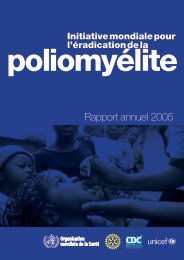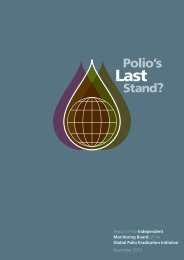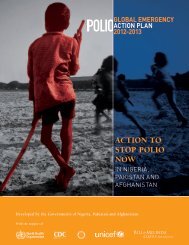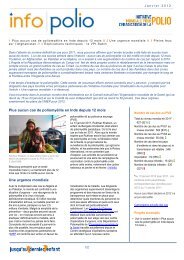national primary health care development agency - Global Polio ...
national primary health care development agency - Global Polio ...
national primary health care development agency - Global Polio ...
You also want an ePaper? Increase the reach of your titles
YUMPU automatically turns print PDFs into web optimized ePapers that Google loves.
Version 13312<br />
The LGA Task Force is responsible for ensuring that priority activities required to ensure high quality<br />
implementation of PEI activities in the LGA are fully implemented as recommended. Specific focus should be paid<br />
to the highest risk wards in the LGA.<br />
LGA Task Forces are expected to provide regular feedback to State Task Force. Wherever required, the State Task<br />
Forces will organize capacity building for LGA Task Forces.<br />
4. ENHANCING SIA QUALITY TO REACH ALL CHILDREN<br />
The main objective of the 2012 PEI emergency plan activities related to SIAs is to achieve and sustain high quality<br />
SIAs that accelerate the attainment of population immunity that is consistently above the threshold required to<br />
achieve interruption of poliovirus transmission (both wild poliovirus and circulating vaccine derived poliovirus) by<br />
the end of 2012 1 .<br />
The 2012 priority activities to enhance SIA quality and ensure that all children are reached including the chronically<br />
missed children are in 3 main categories (a) reviewing and refining basic SIA strategies with emphasis on improving<br />
performance of vaccination teams (b) introducing and scaling up new and proven interventions/initiatives to<br />
characterize and reach chronically missed children and (c) identify and deploy additional human resources to<br />
highest risk areas in the country.<br />
4.1. Review and refine basic SIA Strategies with focus on improving performance of vaccination teams<br />
Priority activities include<br />
• Improve micro-plans so that all settlements are identified and included in the micro-plan. This will be<br />
done through the use of Geographic Information System (GIS) to improve microplans and aid in team<br />
tracking during implementation. Satellite imagery through GIS will be employed in 8 states, with all<br />
settlements to be geo-coded. Microplans will be revised to include all settlements and hamlets. This<br />
project commenced in February in some parts of Jigawa and by March both Jigawa and Kano would have<br />
been reached.<br />
• Ensure that we have well-trained and supervised vaccinator teams with revised team selection process,<br />
coupled with new and standardized vaccinator training. This is essential as there will be new expectations<br />
(hours in the field, line list missed children) of the teams. The ‘B Team’ type revisit strategy will also be<br />
initiated.<br />
• Address problem of irrational team workloads, team shortages and remuneration issues by restructuring<br />
team compositions, employing more teams and testing options tailored to different contexts (location,<br />
population, distance) in March round to inform new operational guidelines. Increased remuneration will<br />
be used to attract a better quality of workers. One GPS tracking device will be given to each vaccinator,<br />
with automatic data upload to a web server. This will auto-generate team-based alert to the LGA for<br />
evening review meetings during SIAs. LGAs will therefore get ‘real time’ information for corrective action<br />
• Provide all vaccination teams with the required logistics, including adequate vaccines, vaccine carriers and<br />
adequate transportation to ensure that they are able to effectively perform the expected functions.<br />
1 EMOD Project, <strong>Global</strong> Good Intellectual Ventures Laboratory. Quarterly Immunity Projections for northern<br />
Nigeria States, February 2012.<br />
10








![English [pdf 2MB] - Global Polio Eradication Initiative](https://img.yumpu.com/6380394/1/190x245/english-pdf-2mb-global-polio-eradication-initiative.jpg?quality=85)
